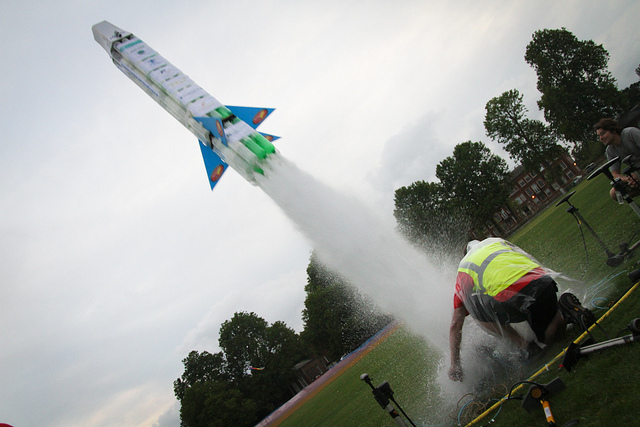Water rocket
 Take your first big step to propel yourself into the world of aerodynamics!
Take your first big step to propel yourself into the world of aerodynamics!
Water Rocket is a mechanical event that involves the fabrication of a rocket whose fuel/thrust for flight is obtained by the use of water that is expelled at a large air pressure. It is an example of Newton's third law of motion. The pre requisites for such an event would be a basic knowledge of fabrication, materials and physical calculations involving thrust, air pressure, etc. The event tests a couple of aspects of the Rocket’s flight. These include range, time of flight and accuracy of the launching mechanism.
Prizes worth INR 12,000
Please post your queries related to this event at http://discuss.pragyan.org/t/water-rocket-event/44
The event consists of three rounds. First one is eliminatory, second is qualifying round and third is the final round.
• First round: Range test
Here the maximum range is tested. The distance between the launch pad and the point of landing is measured and taken to be the points in that round. From this, 15-20 people will be shortlisted for the next round.
• Second round: Accuracy test
At a distance of 70m from the launch pad, a target is placed. Target contains concentric circles of radii 2m, 4m and 6m. If the rocket lands at the centre, team gets 100 points, second ring 75 points, and outer ring 50 points. If otherwise, no points are awarded. Three teams will qualify for the final round. In the case of any tie, the time of flight will be noted and the team with the least time gets into the next round.
• Third round: Battle of rockets
Three teams to get selected (say A,B,C) are assured of prizes, but the battle will be against each other for their position in top three. The targets will be paper castles and will be aligned in an arc. The teams will try to destroy their opponents’ castles. The time taken to destroy an opponent’s castle will be the indicator for positions. For example, the team that manages to destroy the opponent’s castle first/with the least number of attempts will win the first prize.
Max 3 participants. These Participants can be from different colleges too.
· The rocket and its components must be handmade. No readymade rocket is allowed.
· The rocket body should be made only with plastic bottles of aerated soft drinks of maximum capacity 2.5L and should be free of any fabrication failures or dents caused by heat exposure. More than one bottle can be used but the total volume must be less than 2.5L.
· Each team MUST have their own launch pads.
· The water rocket must use only compressed atmospheric air as its source of energy. Pressure compressors (foot pump) shall be provided at the venue. The pressure inside the container (rocket body) before launch should NOT exceed 60 psi for the first two rounds.
· Water to be filled in the rockets will be provided by the organizers. Calculations regarding amount of water to be used is left to the choice of the team.
· Two trials will be given to each team and best of two will be taken into consideration.
· The rocket must be launched from a stationary position using a fixed launch pad. Slingshots, trebuchets, catapults, cannons, and all other devices that may assist launching are strictly prohibited.In other words, the internal pressure of the rocket must be the only source of energy for the rocket.
· Water rockets can have multiple stages. Parachute, gliding mechanisms are permitted.
· Use of electronic components and chemical explosives are banned.
· The point where the rocket hits the ground first will be taken as the point of landing and measurements will be taken considering this point.
· Teams are advised to get more than one water rocket, in case of any damage to one. But the water rockets must be identical.
· The participants are allowed to use variations of their water rockets in different rounds. However, only one design must be maintained throughout a single round.
· The team will be disqualified/given another chance to remodel if the model is found to be dangerous in anyway. Decision of the organizers is final and binding.
· The judgment is completely based on the marking scheme mentioned in the event format.
· The organizers decide to permit the launching of the rocket after inspection of both the rocket and launch pad considering factors such as safety and permissible mechanisms mentioned in the rules. In such cases, the organizers’ decision is final and binding.
Design a water rocket that is completely powered by the thrust delivered by water expelled at high pressure along with its launchpad.
1. Can school students participate as well?
Totally. No barriers at all.
2. What will be the pre-requisites?
Building a water rocket is both fun and quite an easy task. Basic designing and fundamentals in aeromodelling would be sufficient.
3. Will launch pads be provided?
Not in any circumstance. The team has to deal with their launch pads in case if it gets damaged or broken.
4. Will any materials be provided on the spot?
The organisation only provides water, a measuring cup, a bucket and compressors (which will have an in-built pressure gage). Other materials will NOT be provided. However, you could buy items in the stationary shops in the campus.
5. What if the rocket gets destroyed?
The team is expected to deal with the damages and repairs of both their rockets and launch pads, if any such thing occurs. If the team is unable to get them fixed, they will automatically be disqualified. Any destruction of the college property or the models of other teams will lead to direct disqualification.
6. Are we allowed to have mechanisms in our models?
Yes, as long as they do not involve any electronic circuits and chemical explosives. Moreover, any sling-shot or catapult mechanisms in the launch pad will NOT be allowed. Allowed mechanisms are parachute, gliding, multi-stage rocketing, zip tie, etc.
7. Who decides if the team in allowed to participate in the first place?
The event managers’ decision is final in this regard. If any model is found dangerous to the humans or property and if any of the above prohibited mechanisms are used, the team will be disqualified.
8. Will all the participants be given participation certificate?
No. The winners alone get the certificates.
9. Is pre-registration necessary?
It is highly recommended that you pre-register for the event. But you can also register on-spot in the PR desk. The on-spot registration must be done at least one hour prior to the event’s start.
10. Should the model be made even before we come to the college?
Not necessary. You can get the materials and construct your model even inside the campus, but before the event begins, it should be completely ready and functional. If the organisers find the model to be readymade, the team is disqualified. The organisers’ decision is final.
11. Is modification of the model design allowed?
Modification of models in a particular round is prohibited. However, different models can be used in different rounds.
12. How many trials will be given for a team in a particular round?
Strictly two. No more, no less. We will either consider the best of two or the average. The final judging criteria will be intimated before the event begins.
13. What if there is a tie between some teams?
The organisers will decide whether to conduct a tie breaker. The tie breakers will be simple enough that won’t require major changes in the model.
14. How much time will be given for one launch?
Maximum 15 minutes. No additional time will be given.
15. Will I get an additional trial if the rocket fails to launch, i.e. if the rocket doesn’t leave the launch pad itself?
You wouldn’t get any additional trial unless you have one trial left out of the two allowed trials.
16. What will happen if I reach late for the competition?
Punctuality is highly appreciated. But in any case of unavoidable delay, inform the organizers before, so that they would be able to allocate a time slot for you. But if you appear late without informing, you’ll be disqualified.
17. Can we team up with students of other colleges?
Yes, it is allowed. The members could be from different colleges, different branches, different years or even pursuing different degrees (UG and PG).
http://www.aircommandrockets.com/flying_higher.htm
http://www.sciencetoymaker.org/waterRocket/buildWaterRocketLauncher.htm
https://www.youtube.com/watch?v=1t663D_gErg
http://www.waterrocketmanual.com/how_they_work.htm
http://www.txsnapper.eezway.org/txsnapper/tips.html
http://www.npl.co.uk/upload/pdf/wr_booklet_print.pdf
The entire details for water rocket can be downloaded here
Prajish Kumar

Sangamitra Sachindran

Faculty Advisor
Dr. M.Venkata Kirthiga
Assistant Professor
Department - Electrical and Electronics Engineering











